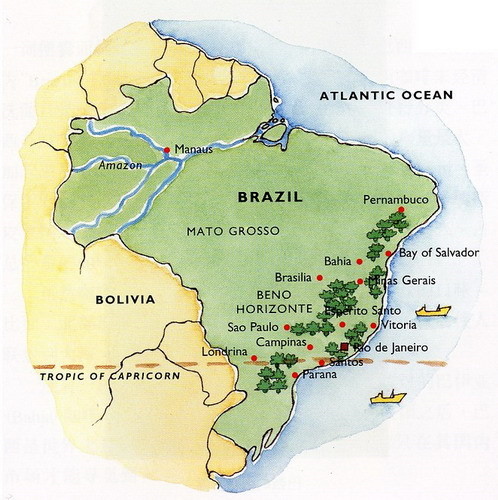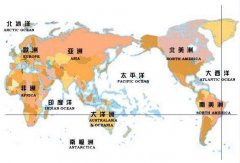Introduction of coffee beans-Brazilian Bourbon Santos Coffee Central and South American Coffee extract
Brazil is a rich and beautiful land, with the Atlantic Ocean in the east, more than 7400 meters of coastline and the famous Andes in the west. Brazil is also the world's largest coffee producer, known as the "coffee country". Brazil is vividly compared to the "giant" and "monarch" of the coffee world.
Brazilian coffee was introduced from French Guiana in 1729. Coffee was originally grown in the north, but the coffee trees did not grow well until 1774, when a Belgian missionary planted coffee in Rio, a warmer and wetter climate in southern Brazil. So far, Rio is also one of the important producers of Brazilian coffee. Brazil grows many kinds of coffee, most of which are not of high quality, but there are also some world-famous products, Bourbon Santos is one of them. This seemingly complicated name sums up the history of this coffee.
The "bourbon" in Bourbon Santos, Brazil comes from the Bourbon Indian Arabica Coffee Tree. The island of Bourbon, now known as Reunion, was once a thriving place for Arabica coffee. Arabik coffee trees grown on the island were introduced around the world, and Brazil's Bourbon Santos is their descendant. Sandoz comes from the port of Sandoz, a port in the Atlantic Ocean in southeastern Brazil. Among the coffee exported from the port of Santos, there are Brazilian coffee from different producing areas, and the more guaranteed quality comes from the southern states of Sao Paulo, Parana and Minas Gerais, of which Minas Gerais has the best quality.
In Brazil, because the planting area of coffee is too large and the degree of mechanized production is relatively high, people often harvest ripe and green fruits together, and there is usually no sorting process. Sometimes coffee fruit is mixed with coffee branches and leaves. Not only that, Brazilian coffee beans are sun-dried, and farmers put coffee beans of different maturity together and expose them in the sun, so that the beans are mixed with soil and various impurities in the first place. sometimes overripe and rotten coffee fruits can also affect the flavor of coffee beans.
For Brazilian Bourbon Santos Coffee, there are no outstanding advantages, but there are no obvious shortcomings. This coffee tastes mild

Important Notice :
前街咖啡 FrontStreet Coffee has moved to new addredd:
FrontStreet Coffee Address: 315,Donghua East Road,GuangZhou
Tel:020 38364473
- Prev

Price of Bourbon Coffee beans Coffee beans Chinese Coffee Honduras Honduras San Juan Theodore 1
The preparation method is to drop a few drops of sherry in deep-fried coffee. The taste of coffee and sherry is very good and the atmosphere of homesickness reaches its climax: there is a remote village in France called bourbon, where the coffee has a sweet and sour taste, which reminds me of the night a long time ago, with multiple flavors, low acidity and lubrication. Entry label: diet, drink
- Next

What is the Yellow Bourbon Coffee Network Coffee Bean Price Indonesian Coffee Bean varieties
It can be understood that bourbon species is a branch of Arabica species, in addition to yellow bourbon, red bourbon, orange bourbon, etc. (in addition to Kaddura, Kaduai, etc.), bourbon species were first planted in bourbon island and Ethiopia. 80-1900 meters above sea level is more suitable for the growth of bourbon coffee beans. Relatively speaking, the output of Huang bourbon is lower, but the quality is better.
Related
- Guji coffee producing area of Guji, Ethiopia: Humbela, Shakiso, Wulaga
- What is the most expensive variety of Qiloso in BOP multi-variety group?
- How to store the coffee beans bought home?
- Why are Yemeni coffee beans so rare now?
- Ethiopian Sidamo all Red Fruit Sun Sun Santa Vini Coffee beans
- SOE is mostly sour? What does it mean? Is it a single bean? what's the difference between it and Italian blending?
- Is Italian coffee beans suitable for making hand-brewed coffee?
- How to choose coffee beans when making cold coffee? What kind of coffee beans are suitable for making cold coffee?
- Just entered the pit to make coffee, what kind of coffee beans should be chosen?
- Can only Japan buy real Blue Mountain Coffee? What are authentic Jamaican Blue Mountain coffee beans?

